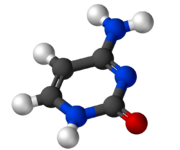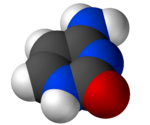Cytosine(/ˈsaɪtəˌsiːn,-ˌziːn,-ˌsɪn/[2][3]) (symbolCorCyt) is one of the fournucleotide basesfound inDNAandRNA,along withadenine,guanine,andthymine(uracilin RNA). It is apyrimidinederivative, with aheterocyclicaromatic ringand two substituents attached (anaminegroup at position 4 and aketogroup at position 2). Thenucleosideof cytosine iscytidine.InWatson–Crick base pairing,it forms threehydrogen bondswithguanine.

| |

| |

| |
| Names | |
|---|---|
| Preferred IUPAC name
4-Aminopyrimidin-2(1H)-one | |
| Other names
4-Amino-1H-pyrimidine-2-one
| |
| Identifiers | |
3D model (JSmol)
|
|
| ChEBI | |
| ChEMBL | |
| ChemSpider | |
| ECHA InfoCard | 100.000.681 |
| KEGG | |
| MeSH | Cytosine |
PubChemCID
|
|
| UNII | |
CompTox Dashboard(EPA)
|
|
| |
| |
| Properties | |
| C4H5N3O | |
| Molar mass | 111.10 g/mol |
| Density | 1.55 g/cm3(calculated) |
| Melting point | 320 to 325 °C (608 to 617 °F; 593 to 598 K) (decomposes) |
| Acidity(pKa) | 4.45 (secondary), 12.2 (primary)[1] |
| -55.8·10−6cm3/mol | |
Except where otherwise noted, data are given for materials in theirstandard state(at 25 °C [77 °F], 100 kPa).
| |
History
editCytosine was discovered and named byAlbrecht Kosseland Albert Neumann in 1894 when it was hydrolyzed from calfthymustissues.[4][5]A structure was proposed in 1903, and was synthesized (and thus confirmed) in the laboratory in the same year.
In 1998, cytosine was used in an early demonstration ofquantum information processingwhen Oxford University researchers implemented theDeutsch–Jozsa algorithmon a twoqubitnuclear magnetic resonance quantum computer (NMRQC).[6]
In March 2015, NASA scientists reported the formation of cytosine, along with uracil and thymine, frompyrimidineunder the space-like laboratory conditions, which is of interest because pyrimidine has been found in meteorites although its origin is unknown.[7]
Chemical reactions
editMethylationof cytosine occurs on carbon number 5.
Cytosine can be found as part of DNA, as part of RNA, or as a part of anucleotide.Ascytidine triphosphate(CTP), it can act as a co-factor to enzymes, and can transfer a phosphate to convertadenosine diphosphate(ADP) toadenosine triphosphate(ATP).
In DNA and RNA, cytosine is paired withguanine.However, it is inherently unstable, and can change intouracil(spontaneous deamination). This can lead to apoint mutationif not repaired by theDNA repairenzymessuch as uracil glycosylase, which cleaves a uracil in DNA.
Cytosine can also bemethylatedinto5-methylcytosineby an enzyme calledDNA methyltransferaseor be methylated andhydroxylatedto make5-hydroxymethylcytosine.The difference in rates of deamination of cytosine and 5-methylcytosine (to uracil andthymine) forms the basis ofbisulfite sequencing.[8]
Biological function
editWhen found third in acodonofRNA,cytosine is synonymous withuracil,as they are interchangeable as the third base. When found as the second base in a codon, the third is always interchangeable. For example, UCU, UCC, UCA and UCG are allserine,regardless of the third base.
Active enzymatic deamination of cytosine or 5-methylcytosine by theAPOBECfamily of cytosine deaminases could have both beneficial and detrimental implications on various cellular processes as well as on organismal evolution.[9]The implications of deamination on 5-hydroxymethylcytosine, on the other hand, remains less understood.
Theoretical aspects
editUntil October 2021, Cytosine had not been found in meteorites, which suggested the first strands of RNA and DNA had to look elsewhere to obtain this building block. Cytosine likely formed within some meteorite parent bodies, however did not persist within these bodies due to an effectivedeaminationreaction intouracil.[10]
In October 2021, Cytosine was announced as having been found in meteorites by researchers in a joint Japan/NASA project, that used novel methods of detection which avoided damaging nucleotides as they were extracted from meteorites.[11]
References
edit- ^Dawson, R.M.C.; et al. (1959).Data for Biochemical Research.Oxford: Clarendon Press.
- ^"Cytosine".Dictionary.com Unabridged(Online). n.d.
- ^"Cytosine".Merriam-Webster.com Dictionary.Merriam-Webster.
- ^A. Kossel and Albert Neumann (1894)"Darstellung und Spaltungsprodukte der Nucleïnsäure (Adenylsäure)"(Preparation and cleavage products of nucleic acids (adenic acid)),Berichte der Deutschen Chemischen Gesellschaft zu Berlin,27:2215–2222. The name "cytosine" is coined on page 2219:"…ein Produkt von basischen Eigenschaften, für welches wir den Namen" Cytosin "vorschlagen."(… a product with basic properties, for which we suggest the name "cytosine".)
- ^Kossel, A.; Steudel, H. Z. (1903)."Weitere Untersuchungen über das Cytosin".Physiol. Chem.38(1–2): 49–59.doi:10.1515/bchm2.1903.38.1-2.49.
- ^Jones, J.A.; M. Mosca (1998-08-01)."Implementation of a quantum algorithm on a nuclear magnetic resonance quantum computer".J. Chem. Phys.109(5): 1648–1653.arXiv:quant-ph/9801027.Bibcode:1998JChPh.109.1648J.doi:10.1063/1.476739.S2CID19348964.Archived fromthe originalon 2008-06-12.Retrieved2007-10-18.
- ^Marlaire, Ruth (3 March 2015)."NASA Ames Reproduces the Building Blocks of Life in Laboratory".NASA.Archived fromthe originalon 5 March 2015.Retrieved5 March2015.
- ^Hayatsu, Hikoya (2008)."Discovery of bisulfite-mediated cytosine conversion to uracil, the key reaction for DNA methylation analysis — A personal account".Proceedings of the Japan Academy. Series B, Physical and Biological Sciences.84(8): 321–330.Bibcode:2008PJAB...84..321H.doi:10.2183/pjab.84.321.ISSN0386-2208.PMC3722019.PMID18941305.
- ^Chahwan R.; Wontakal S.N.; Roa S. (2010). "Crosstalk between genetic and epigenetic information through cytosine deamination".Trends in Genetics.26(10): 443–448.doi:10.1016/j.tig.2010.07.005.PMID20800313.
- ^Tasker, Elizabeth."Did the Seeds of Life Come from Space?".Scientific American Blog Network.Retrieved2016-11-24.
- ^Yasuhiro Oba; Yoshinori Takano; Yoshihiro Furukawa; Toshiki Koga; Daniel P. Glavin; Jason P. Dworkin; Hiroshi Naraoka."Identifying the wide diversity of extraterrestrial purine and pyrimidine nucleobases in carbonaceous meteorites".The Journal of Nature Communications.Nature.com.Retrieved7 July2022.
External links and citations
edit- Cytosine MS Spectrum
- EINECS number200-749-5
- Shapiro R (1999)."Prebiotic cytosine synthesis: a critical analysis and implications for the origin of life".Proc. Natl. Acad. Sci. U.S.A.96(8): 4396–401.Bibcode:1999PNAS...96.4396S.doi:10.1073/pnas.96.8.4396.PMC16343.PMID10200273.